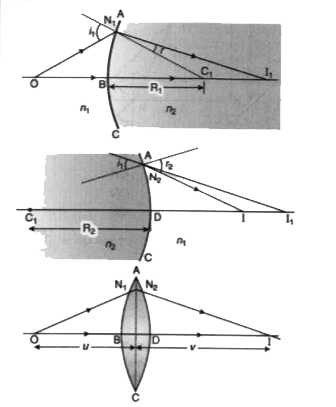(a) A point object is placed in front of a double convex lens ( of refractive index n=n2/n1 with respect to air ) with its spherical faces of radii of curvature R1 and R2. Show the path of rays due to refraction at first and subsequently at the second surface to obtain the formation of the real image of the object.
Hence obtain the lens-maker's formula for a thin lens.
A double convex lens having both faces of the same radius of curvature has refractive index 1.55. Find out the radius of curvature of the lens required to get the focal length of 20cm. Solution in Kannada
(a) 
The first refracting surface ABC forms the image I1 of the object O. The image I1 acts as a virtual object for the second refracting surface ADC, which forms the real image I as shown in the diagram.
For refraction at ABC.
n2v1−n1u=n2−n1R1 ...(i)
For refraction at ADC
n1v−n2v1=n1−n2R2 ....(ii)
Adding equations (i) and (ii)
n1v−n1u=(n2−n1)(1R1−1R2)
1v−1u=(n2n1−1)(1R1−1R2)
We know, If u=∞,v=f
1v−1u=1f
1f=(n2n1−1)(1R1−1R2)
1f=(μ21−1)(1R1−1R2)
(b) 1f=(μ21−1)(1R1−1R2)
120=(1.55−1)(1R−1−R)
=0.55×2R
R=0.55×2×20=22cm
Topper's Solved these Questions
- RAY OPTICS AND OPTICAL INSTRUMENTSBook:OSWAAL PUBLICATIONChapter:RAY OPTICS AND OPTICAL INSTRUMENTSExercise:TOPIC-1(NUMERICAL PROBLEMS)
Explore 9 Videos
- RAY OPTICS AND OPTICAL INSTRUMENTSBook:OSWAAL PUBLICATIONChapter:RAY OPTICS AND OPTICAL INSTRUMENTSExercise:TOPIC-2(VERY SHORT ANSWER TYPE QUESTIONS)
Explore 4 Videos
- RAY OPTICS AND OPTICAL INSTRUMENTSBook:OSWAAL PUBLICATIONChapter:RAY OPTICS AND OPTICAL INSTRUMENTSExercise:TOPIC-1(SHORT ANSWER TYPE QUESTIONS-2)
Explore 6 Videos
- NUCLEIBook:OSWAAL PUBLICATIONChapter:NUCLEIExercise:TOPIC -2 (Numerical Problems)
Explore 3 Videos
- Sample Paper 1Book:OSWAAL PUBLICATIONChapter:Sample Paper 1Exercise:Exercise
Explore 36 Videos
Similar Questions
A convex lens of focal length 0.24 m and of refractive index 1.5 is completely immersed in water of refractive 1.33. Find the changes in the focal length of the lens.
View SolutionWhat is dispersion of light?
View SolutionDerive the relation f=R/2 in the case of a concave mirror.
View SolutionThe half life of 38Sr90 isotope is 28 years. What is the rate of disintegration of 15 mg of this isotope? (Given Avogadro No =6.023×1023)
View SolutionCharges of 10μC and 15μC are separated by a certain distance. Which charge repels the other with a greater force?
View SolutionA thin bi-convex lens made up of glass of refractive index 3/2 is placed is front of a plane mirror. The space between the lens and the mirror is filled with water of refractive index 4/3 . The radii of curvatures of the lens are R1=15cm and R2=25cm . A point object is placed at distance x from the surface whose curvature is R1. The distance x is greater than the separation between the lens and the mirror. Find the value of x so that image must coincide with the object.
View SolutionOne surface of a lens is convex and the other is concave, if the radii of curvature are r_(1) and r_(2) respectively, the lens will be convex if
View SolutionA biconvex lens made of material with refractive index n2. The radii of curvatures of its left surface and right surface are R1 and R2. The media on its left and right have refreactive indices n1 and n3 respectively. The first and second focal lengths of the lens are respectively f1 and f2.
Assume that R1=R2,n1≠n3. The ratio, f1/f2, of the two focal lengths is equal to
View Solution(a) Draw the ray diagram showing the geometry of formation of the image of a point object situated on the principal axis, and on the convex side, of a spherical of radius of curvature R . Taking the rays as incident from a medium of refractive index n_(1) to anothr of refractive index n_(2) show that (n_(2))/(v)-(n_(1))/(u)=(n_(2)-n_(1))/(R) where the symbols have their usual meaning. (b) Use this relation to obtain the (thin) lens maker's formula.
View Solution(i) Device the mathematical n between refractive indices n1 and n2 of two radii and radius of curvature R for refraction at a convex shperical surface. Consider the object to be a point since lying on the principal axis in rarer medium of refractive index n1 and a real image formed in the denser medium of refractive index n2. Hence, derive lens marker's formula.
(ii) Light from a point source in air falls on a convex spherical glass surface of refractive index 1.5 and radius of curvature 20cm. The distance of light source from the glass surface is 100cm. At what position is the image formed ?
View Solutionएक पतले लेंस के लिए फोकस दुरी का सूत्र अपवर्तनांक तथा वक्रता त्रिज्याओं के पदों में लिखिए! (अथवा) किसी उत्तल लेंस की फोकस दुरी f अपवर्तनांक n एवं लेंस की वक्रता त्रिज्याओं R1 व R2 के बिच सम्बन्ध लिखिए!
View SolutionA double convex lens whose radii of curvature are R_(1) and R_(2) forms the image of a point object, placed on its axis. If the lens is revered, face to face, then the ratio of the distances of the images in the first and second case will be
View Solutionn1 और n2 अपवर्तनांकों वाले दो माध्यमों को पृथक करने वाले गोलीय पृष्ठ के अक्ष पर पड़ी एक बिन्दु वस्तु के प्रतिबिम्ब की रचना दिखने वाली प्रकाश किरणों का अनुरेखण करें | वस्तु और प्रतिबिम्ब की दूरियों और गोलीय पृष्ठ के केन्द्रीय बिन्दु से वक्रता व्यासार्ध के बीच सम्बन्ध स्थापित करें | इससे लेन्स निर्माता सूत्र के लिए व्यंजक निकालें |
View SolutionA real object is kept in air and refraction occurs at the convex boundry of a spherical glass surface. For the image to be real, the real object distance (ng=3/2)
View SolutionDraw a ray diagram showing the formation of the image by a point object on the principal axis of a spherical convex surface separating two media of refractive indices n1 and n2, when a point source is kept in rarer medium of refractive index n1. Derive the relation between object and image distance in terms of refractive index of the medium and radium of curvature of the surface.
Hence obtain the expression for lens-maker's formula in the case of thin convex lens.
View Solution